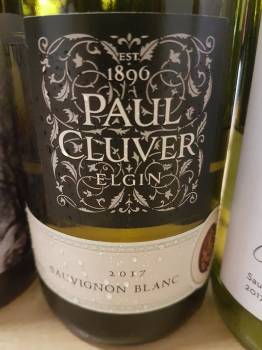Sauvignon Blanc benchmark tasting
By Christian Eedes, 22 January 2018
On Friday, Paul Cluver Estate in Elgin held a tasting to gauge the quality of its own Sauvignon Blanc against some of the other leading practitioners of the variety locally. There were 24 wines in all, 17 from the 2017 vintage and five from the 2016 vintage, with these tasted blind in three flights of six and one of four.
The line-up was as follows (with notable competition achievements in bold):
Cape of Good Hope Altima 2016
Cape Point Vineyards Reserve 2016
Constantia Glen 2017 (5 Stars in Platter’s 2018)
David Nieuwoudt Ghost Corner 2017
De Grendel 2017
De Grendel Koetshuis 2017
Diemersdal Eight Rows 2017
Diemersdal Reserve 2017 (Veritas DG)
Durbanville Hills Rhinofields 2017
Grand Vin de Stellenbosch 2017 (Origin Wines) (Veritas DG)
Groot Phesantekraal 2017 (Veritas DG, FNB Top 10)
Iona 2017
Klein Constantia Metis 2016
La Motte Pierneef 2016
Nitida Golden Orb 2016
Oak Valley Fountain of Youth 2017 (5 Stars in Platter’s)
Paul Cluver 2017
Spier Creative Block 2 2017
Spier 21 Gables 2017
Sophie 2017 (Iona)
Tokara Reserve Collection Elgin 2017
Van Loveren Family Christina van Loveren 2017 (5 Stars in Platter’s)
My top 10 were as follows:
1.= Cape Point Vineyards Reserve 2016 – 94
1.= La Motte Pierneef 2016 – 94
3.= Diemersdal Reserve 2017 – 93
3.= Groot Phesantekraal 2017 – 93
3.= Klein Constantia Metis 2016 – 93
6.= Diemersdal Eight Rows 2017 – 92
6.= Iona 2017 – 92
6.= Spier 21 Gables 2017 – 92
9. David Nieuwoudt Ghost Corner 2017 – 91
10.= De Grendel 2017 – 90
10.= Paul Cluver 2017 – 90
The overall top four were:
1.= Cape Point Vineyards Reserve 2016 – 93
1.= Diemersdal Reserve 2017 – 93
1.= La Motte Pierneef 2016 – 93
2. Groot Phesantekraal 2017 – 92
Some general observations: The overall standard of top-end South African Sauvignon Blanc is now very good with producers possessing a good understanding of how to get pyrazines (chemical compounds responsible for “green” aromas and flavours) to play off against thiols (tropical fruit) to best effect. In addition, acidities seem much better integrated than even a few years ago, the old joke of having to keep antacid to hand when drinking Sauvignon less and less applicable.
Producers are legally allowed up to 15% of Semillon in their wine and obviously are going to exploit this ruling if they feel it will make a better wine. Past a certain point, however, and some of the wines start to have the weight and complexity of a “Bordeaux blend” rather than the purity of a single-variety Sauvignon – the Spier Creative Block 2 2017 contains 14% Semillon, while the Paul Cluver 2017 9% as does the Cape Point Vineyard 2016. A case of wanting to have your cake and eat it, too?
Regarding the top wines, the Cape Point Vineyards, which is matured in older 600-litre barrels for 15 months in addition to featuring Sem, appeared noticeably if winningly oxidative relative to everything else. The La Motte Pierneef, meanwhile, impressed all in attendance with its precision while the Diemersdal Reserve and the Groot Phesantekraal both managed to combine complexity and balance with forcefulness.









Comments
0 comment(s)
Please read our Comments Policy here.